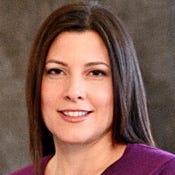HP Shows People-To-People Is Only A StartHP Shows People-To-People Is Only A Start
HP's webOS vision represents a multi-device mobile world that integrates personal and professional communications.

When new Hewlett-Packard CEO Leo Apotheker laid out his vision last month, he grabbed attention with his line that HP could soon be shipping over 100 million devices with webOS, including printers, tablets, phones, PCs and other yet-to-be-named devices.
That idea took on a deeper meaning when other HP executives discussed how HP's webOS software would be used in the future, including how HP's Synergy, a feature of webOS, allows people to integrate their corporate and social worlds.
With Synergy, a person signs in to networks such as Facebook, Google, or Microsoft Exchange, and the data from these services--such as email, contacts, and calendars--automatically populates and updates the user's HP smartphone. This feature is promised for the HP Touchpad tablet to be launched in June and future HP PCs and printers. The company demonstrated integrated messaging that combines text messages, picture messages, and IM conversations with one person into a single view, regardless of where the actual exchange was initiated. It also showed how users could choose to answer an SMS on their phones or tablets.
While these features only operate across HP devices today, they are an indicator of things to come for the industry. This is a fundamental shift in the computing industry from a largely Microsoft Window's world that connected desktops and laptops to a new world of connected devices that will be based on a much more fragmented environment of operating systems. The battle for the next generation operating systems has already begun. Apple has shipped 100 million iPhones and 15 million tablets with iOS, and Google claims 350,000 Android devices are activated per day. RIM has its tablet out with a new OS, and Nokia is teaming with Microsoft to use Windows Phone 7 for the next generation of its mobile devices.
These changes have a widespread impact on the Enterprise 2.0 community. The software we are building today is largely grounded in a traditional Microsoft Windows world. While it takes mobile connectivity into consideration, it hasn't been designed from the ground up as a mobile application. But mobile isn't just another channel. The shift in operating systems and the creation of a new applications landscape indicate a more fundamental change.
HP's comments on adding webOS to everything is a wake-up call to the communications and collaboration industry that Enterprise 2.0 communications is morphing into a world where consumers expect services to work on multiple devices and expect those services to be able to tap into context such as location, weather, device capabilities, and presence. I call this context-aware communications.
HP's vision represents a multi-device mobile world that integrates personal and professional communications. HP's vision integrates cloud services like LinkedIn with data that may be on-premises such as Exchange. The vision also breaks down the boundaries of where and over what device we access services, such as SMS moving beyond the phone to tablets. HP's vision is one example of the industry moving beyond the Enterprise 2.0 vision of integrating just business communications with a layer of social communications such as microblogging within the enterprise to offering a unified view of a person's communications. Even calling it Enterprise 3.0 communications isn't right, though, because it goes far beyond business communications to integrate your personal communications as well.
Today's communications software is limited to people to people, whereas context-aware communications will include people to things and things to things as well as people to people. It will extend beyond today's basic presence and status. Presence will span across devices to include non-traditional devices such as cars and be aware of the device types' capabilities (e.g. video, touch screen, accelerometers). Multiple types of location technologies--such as triangulation, wireless location signatures, and GPS--will be combined to provide rich indoor and outdoor location for both people and things. In the future, embedded sensors that provide environmental conditions such as humidity and temperature will be commonplace. Sensors will provide another aspect of context that communications systems can tap into.
Imagine a world where a truck can alert the transportation company if the refrigeration unit onboard isn't functioning properly. If you're running late for a meeting in downtown L.A., your car can connect to services like Streetline to help you find an available parking spot. A nurse can locate a doctor on the third floor of a hospital. A world where you decide what information you want to expose and to what individuals. For example, you can decide to share with your coworkers if you are in the car and talking on your mobile phone or if you've "checked in" to a Starbuck's. Each of these exists but isn't commonplace or easy. While the mobile landscape is fragmented today, it represents an opportunity for Enterprise 2.0 providers to thrive by creating new context-aware communications.
Maribel Lopez is the founder of Lopez Research and vice president of Constellation Research Group. She can be reached at [email protected] or 415-894-5781.
Attend Enterprise 2.0 Boston to see the latest social business tools and technologies. Register with code CPBJEB03 and save $100 off conference passes or for a free expo pass. It happens June 20-23. Find out more.
About the Author
You May Also Like






